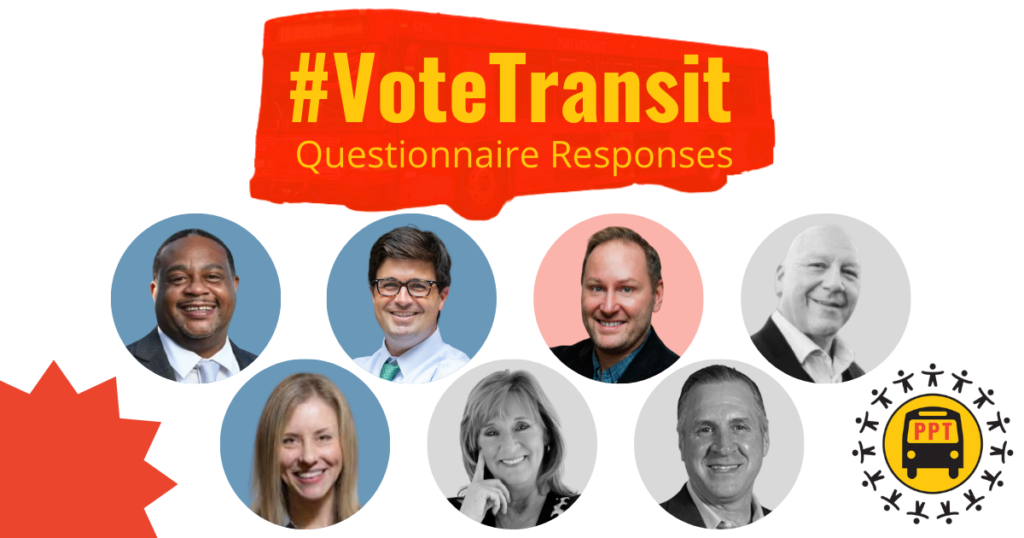
Read what the Candidates running to be PGH’s next Mayor & City Council Representatives have to say about public transit. Take our #VoteTransit Pledge to commit to electing Transit Champion!
With Election Day around the corner on May 20th, city residents will have the chance to choose who should be Pittsburgh’s next Mayor & City Council representatives. We at Pittsburghers for Public Transit know that there is a lot that City and municipal leaders can do to improve access to public transit – from improving sidewalks, to building bus shelters, to creating land use and employee policy that support transit access – even though the Mayor & City Council don’t have direct control over the transit agency itself.
This year, we put together our #VoteTransit 25/25/25 Goal for candidates running to lead our city–and we want them to commit!
Pittsburghers for Public Transit’s Transit 25/25/25 Goals:
Mayoral and City Council candidates must pledge to:
- Close 25% of the City’s Sidewalk Network Gaps
- Install 25 New Bus Shelters Per Year
- Ensure 25% of the New Housing Units Built Near Our Best Transit Assets are Deeply Affordable
Pittsburghers for Public Transit held a Mayoral Forum on April 9th (which was attended by all candidates except Corey O’Connor).
We also issued a short two-question #VoteTransit Candidate Questionnaire to every candidate running in the races for Pittsburgh Mayor and City Council. In the Mayoral race, responses were submitted by Democrats Mayor Ed Gainey and Cory O’Connor, and Republican Thomas West. In the Pittsburgh City Council races, responses were submitted by Councilperson Erika Strassburger, who’s running to continue representing District 8.
Read on to learn what each candidate said about our goal to build more bus shelters, better sidewalks, and more deeply affordable housing near great transit. And join more than 2,000 people who’ve taken the #VoteTransit pledge to vote for *Transit Champions* on Election Day! How can you get ready for Election day? Check your polling place here! and pledge to #VoteTransit below!
#VoteTransit Questionnaire Responses from Democratic candidates for Mayor of Pittsburgh:
1. Do you agree with the #VoteTransit 25/25/25 Goals? If not, what targets would you set as Mayor in this coming term around sidewalk network gap closure, new bus shelter deployment, and the development of more units of affordable housing by the busways, T and our frequent service corridors?

Mayor Ed Gainey
I agree with these goals. From the beginning of my administration, I have stood with transit riders, bike/ped advocates, and everyone in our community who has a vision of how to make equitable mobility a reality in our city. These goals are a powerful next step that have been created by people directly impacted by these issues and I look forward to working with you to implement them.

Corey O’Connor
Yes, I agree with the goals above. Closing sidewalk gaps, adding additional bus shelters, and building more deeply affordable housing near transit would all work together to make our city a safer, more accessible, and more pleasant place to live.
2. For the targets that you are proposing, what are your specific plans to fund and implement the sidewalk network gap closure, install the new bus shelters per year, and ensure housing by transit is affordable? What are the obstacles that you see in meeting your goals, and how would you overcome them?

Mayor Ed Gainey
Sidewalks: When it comes to sidewalks in our city, we have an archaic system that places responsibility for sidewalk maintenance with the property owner. This means that property owners in wealthier communities are better able to keep their sidewalks in good repair than people in lower-income communities. My administration has begun to
address this issue with a pilot program that uses city resources to replace large sections of sidewalk – which is more cost effective than having a single property owner replace their own sidewalk – then bills that back to the property owner at cost, and on a payment plan as needed. Not only is it less expensive for the property owner, it allows
large sections of sidewalk gap to be repaired at once and increases equitable access to ccessible sidewalks.
Because of this system, as well as the City’s funding constraints over the next two years, closing 25% of the sidewalk network gap will require creativity, persistence, and partnership. Cities like Denver, with its sidewalk fee, are coming up with innovative ways to repair sidewalks and fill gaps. I’d like to work with Pittsburghers for Public Transit, the Department of Mobility and Infrastructure, and City Council to consider solutions to come up with the revenue necessary to close this gap over the next four years.
Bus shelters: One way to potentially identify the revenue necessary to create 25 new shelters per year would be for the city to take over shelters from Gateway and start bringing in that ad revenue ourselves – then using that to install more shelters.
Affordable Housing: We can only achieve the goal of 25% of new units near our best transit assets being deeply affordable if we create deep partnerships between the Urban Redevelopment Authority, the Housing Authority, and our other affordable housing partners. My administration has modeled how this is possible by creating and
preserving 2,000 units of affordable housing in our first term and beginning a process to reshape the Housing Authority. My administration also has bills currently before the Planning Commission and City Council both for transit-oriented development as well as Inclusionary Zoning, which would require that 10% of all housing built in our high-density zones, including transit corridors, be affordable. It’s proving to be a battle because many of our market-rate developers and their allies on City Council simply don’t want to participate in that – no matter how many tax breaks and density incentives we offer to let them build more and make more money. We’ll continue to move toward this goal using all our resources; from organizing ordinary Pittsburghers in every neighborhood to continuing to demonstrate the effectiveness of our affordable housing development. In a second term, I hope to partner with PPT to select a set of transit stations or neighborhoods with best-in-class transit to create flagship projects that demonstrate to the city what a transit-oriented future will look like.

Corey O’Connor
Meeting these ambitious goals will require a combination of local investment, state grants, and innovative funding mechanisms, as obtaining federal funds under the current administration will be challenging. For sidewalk gap closures, I’d prioritize city capital funds and public-private partnerships, focusing on high-traffic areas. A major obstacle will be private property owners’ reluctance to take on legal responsibility, as the city must sign agreements with each owner before making improvements. Bus shelter installations can be streamlined by working with transit agencies and leveraging private sponsorships or advertising revenue. To ensure affordable housing near transit, I support investing in site preparation, making permitting easier, and expanding financial incentives to accelerate construction. The key obstacles are funding constraints and bureaucratic delays, which I’d address through more efficient permitting processes and targeted investment strategies.
#VoteTransit Questionnaire Responses from Democratic candidates for Pittsburgh City Council:
1. Do you agree with the #VoteTransit 25/25/25 Goals? If not, what targets would you set as Mayor in this coming term around sidewalk network gap closure, new bus shelter deployment, and the development of more units of affordable housing by the busways, T and our frequent service corridors?

Erika Strassburger, PGH City Council District 8
I support PPT’s 25/25/25 goals. We need bold goals such as these to help Pittsburghers shift from a car-centric culture to one that prioritizes public transportation and last-mile modes such as biking, walking, and rolling. In some communities, the barriers are physical – dangerous sidewalks or no sidewalks, uncomfortable and unwelcoming bus shelters or bus stops with no shelter. In other communities, the barriers are more psychological – the amenities might exist, but the buses are perceived to be or are too unreliable or too infrequent to encourage easy use. Denser housing around transit corridors and stations would help drive the usage of those lines, and more affordable housing in these areas would go a long way to ensuring that all residents can live in neighborhoods with excellent amenities and that they can travel to work, school, or other neighborhoods with ease.

Kim Salinetro, Candidate for PGH City Council District 2
[Kim Salinetro did not respond to PPT’s #VoteTransit Candidate Questionnaire]

Anthony Coghill, PGH City Council District 4
[Anthony Coghill did not respond to PPT’s #VoteTransit Candidate Questionnaire]
2. For the targets that you are proposing, what are your specific plans to fund and implement the sidewalk network gap closure, install the new bus shelters per year, and ensure housing by transit is affordable? What are the obstacles that you see in meeting your goals, and how would you overcome them?

Erika Strassburger, City Council District 8
Funding is the largest barrier to reaching all three of these goals. First, any deal with our major five non-profits to receive non-taxable income should include a line item for sidewalks and bus shelters. Workers, students, and visitors to all five of our largest eds and meds institutions rely on public transportation, so their dollars would be going directly toward improving the accessibility of the people using their services. Second, the City could set up a special trust fund for sidewalks and bus shelters. The trust fund could be funded through several methods – advertising on city amenities, increased permit fees for various activities or events, or even a special voter referendum-approved tax. The trust fund would help ensure a constant stream of funding that remained separate from the general fund. This would allow the city to continue the work it has initiated to build and repair sidewalks on whole city blocks around City-owned property that is currently vacant or abandoned and not yet churning through our Land Bank.
Funding for the affordable housing near transit corridors is also an obstacle, but in a different way. As transit-oriented development zoning overlays are proposed and rolled out, affordability should be a requirement. That said, given the soaring cost of the development of housing units, housing is not likely to be built (with affordability) without some way to close the financing gaps. Whether the Housing Opportunity Fund can shift to create a line item for these transit-oriented development areas, or whether tax abatements such as LERTAs or TIFs might be the answer, there needs to be some way to provide a carrot along with the stick. Additionally, for deeply affordable units (30% AMI and below), there must be a partnership with the Allegheny County Department of Human Services to ensure the appropriate wrap-around services are available and are funded.

Kim Salinetro, Candidate for City Council District 2
[Kim Salinetro did not respond to PPT’s #VoteTransit Candidate Questionnaire]

Anthony Coghill, City Council District 4
[Anthony Coghill did not respond to PPT’s #VoteTransit Candidate Questionnaire]
Pittsburghers for Public Transit’s #VoteTransit Questionnaire, as answered by Republican candidates for Mayor of Pittsburgh
1. Do you agree with the #VoteTransit 25/25/25 Goals? If not, what targets would you set as Mayor in this coming term around sidewalk network gap closure, new bus shelter deployment, and the development of more units of affordable housing by the busways, T and our frequent service corridors?

Thomas West
I agree with the intent behind these goals — making Pittsburgh safer, more connected, and more affordable for working families — but I also believe in setting realistic, fiscally responsible targets that reflect our city’s current budget constraints and economic challenges.
- Sidewalk Network Gaps: Sidewalks are not just about safety — they’re a fundamental part of our city’s infrastructure and directly impact quality of life. I support the goal of closing 25% of network gaps, but more importantly, I believe we must prioritize neighborhoods with the highest need first — particularly those with schools, senior populations, and high pedestrian traffic. These communities can’t afford to be left behind.
- Bus Shelters: With PRT facing financial instability and possible service cuts, our first priority must be preserving access to reliable, functional transit. Once that stability is addressed, I would support a goal of installing up to 25 new shelters annually, but only if we can ensure each one is placed where it’s actually needed — not just to hit a number.
- Affordable Housing Near Transit: I do not support mandates that dictate where or what type of housing must be built. I believe in incentivizing development and creating conditions where affordable housing can thrive organically — not through one-size-fits-all policies. We need to focus on neighborhood revitalization
that drives private investment, job creation, and ultimately, homeownership — not just rental units stacked by transit stops.

Tony Moreno
[Tony Moreno did not respond to PPT’s #VoteTransit Candidate Questionnaire]
2. For the targets that you are proposing, what are your specific plans to fund and implement the sidewalk network gap closure, install the new bus shelters per year, and ensure housing by transit is affordable? What are the obstacles that you see in meeting your goals, and how would you overcome them?

Thomas West
- Sidewalks: The City of Pittsburgh has mismanaged millions in taxpayer dollars over the years — it’s time to get back to the basics. As Mayor, I will audit current infrastructure spending and identify waste to reallocate funds to critical priorities like sidewalks. I will also pursue public-private partnerships and state/federal infrastructure grants — but every dollar must be accountable. No more throwing money at problems without a plan or a result.
- Bus Shelters & Transit Support: With PRT facing a fiscal cliff, I will be a vocal advocate in Harrisburg and Washington. Philadelphia has a seat at the table — Pittsburgh needs one too. But while we fight for funding, we must also ensure that current transit dollars are used efficiently. Every shelter should be placed based on data — ridership, need, and accessibility — not political pressure. We must stop chasing headlines and start chasing results.
- Affordable Housing: We don’t need more top-down mandates. What we need is economic opportunity in every corner of the city. That starts with cutting red tape for small businesses, investing in workforce development, and supporting local entrepreneurs. When you bring jobs into underserved neighborhoods, you create demand for housing — and that’s when developers step in. My goal is to create environments where affordable housing is a market-driven result of growth, not a politically dictated outcome.

Tony Moreno
[Tony Moreno did not respond to PPT’s #VoteTransit Candidate Questionnaire]